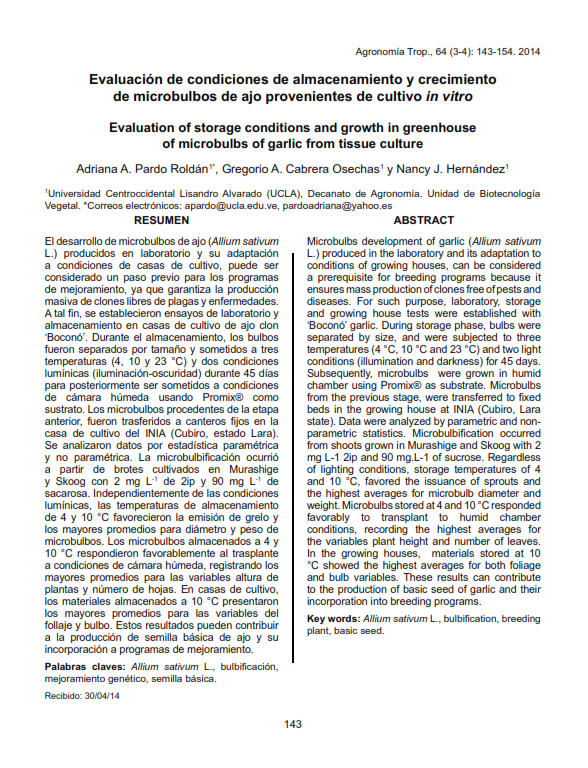Evaluation of storage conditions and growth in greenhouse of microbulbs of garlic from tissue culture
Abstract
Microbulbs development of garlic (Allium sativum L.) produced in the laboratory and its adaptation to conditions of growing houses, can be considered a prerequisite for breeding programs because it ensures mass production of clones free of pests and diseases. For such purpose, laboratory, storage and growing house tests were established with ‘Boconó’ garlic. During storage phase, bulbs were separated by size, and were subjected to three temperatures (4 °C, 10 °C and 23 °C) and two light conditions (illumination and darkness) for 45 days. Subsequently, microbulbs were grown in humid chamber using Promix® as substrate. Microbulbs from the previous stage, were transferred to fixed beds in the growing house at INIA (Cubiro, Lara state). Data were analyzed by parametric and non- parametric statistics. Microbulbification occurred from shoots grown in Murashige and Skoog with 2 mg L-1 2ip and 90 mg.L-1 of sucrose. Regardless of lighting conditions, storage temperatures of 4 and 10 °C, favored the issuance of sprouts and the highest averages for microbulb diameter and weight. Microbulbs stored at 4 and 10 °C responded favorably to transplant to humid chamber conditions, recording the highest averages for the variables plant height and number of leaves. In the growing houses, materials stored at 10 °C showed the highest averages for both foliage and bulb variables. These results can contribute to the production of basic seed of garlic and their incorporation into breeding programs.
Downloads
References
• Bhojwani, S. 1980. In vitro propagation of garlic by shoot proliferation. Scientia Horticulturae. 13:47-52.
• Burba, J., R. Ocañas, G. Lanzavechia y M. Paganini. 2007. Manejo de semilla básica de ajo en condiciones controladas. Ediciones: Instituto Nacional de Tecnología Agropecuaria (INTA). Argentina. 23 p.
• Burba, J. 2009. Mejoramiento genético y producción de “semilla” de ajo (Allium sativum L), posibilidad de adaptación a diferentes ambientes. Instituto Nacional de Tecnología Agropecuaria (INTA). Argentina. 44 p.
• Brewster, J. 2001. Las cebollas y otros Alliums. Editorial Acribia, S. A. Zaragoza, España. 266 p.
• James, C., V. Seignemartin y S. James. 2009. The freezing and supercooling of garlic (Allium sativum L.). International Journal of Refrigeration. 32:253-260.
• Luciani, G., A. Mary, C. Pellegrini y N. Curvetto. 2006. Effect of explant and growth regulators in garlic callus formation and plant regeneration. Plant cell tissue and organs culture. 87:139-143.
• Mathew, D., Y. Forer, H. Rabinowitch and R. Kamenetsky. 2011. Effect of long photoperiod on the reproductive and bulbing processes in garlic (Allium sativum L.) gennotypes. Enviromental and Experimental Botany. 71:166-173.
• Moriconi, D., V. Conci and S. Nome. 1990. Rapid multiplication of garlic (Allium sativum L.) in vitro. Phyton. 51:145-151.
• Mujica, H. y N. Mogollón. 2004. Bulbificacion in vitro del ajo (Allium sativum L.) con adición de citocininas y sacarosa en el medio de cultivo. Bioagro. 16(1):55-60.
• Mujica, H., M. Sanabria, N. Mogollón y Y. Perozo. 2008. Formación in vitro del bulbo de ajo morado (Allium sativum L.). Revista de la Facultad de Agronomía de la Universidad del Zulia. 25(2):197-210.
• Murashige, T. and F. Skoog. 1962. A review medium for rapid growth and biossays with tobacco tissue cultures. Physiología Plantarum. 1:473-497.
• Nagakubo, T., A. Nagasawa and H. Ohkawa. 1993. Micropropagation of garlic through in vitro bulblet formation. Plant Cell Tissue Organ Culture. 32:175-183.
• Palmero, D., L. Gálvez, M. García, J. Gil and S. Benito. 2013. The effects of storage duration, temperature and cultivar on the severity of garlic clove rot caused by Fusarium proliferatum. Postharvest Biology and Technology. 78:34-39.
• Vázquez, M., G. López., E. Mercado, E. Castaño and F. León. 2006. Study and prediction of quality changes in garlic cv. Perla (Allium sativum L.) stored at different temperatures. Scientia Horticulturae. 108:127-132.
• Zheng S., B. Henken, F. Krens and C. Kik. 2003. The development of an efficient cultivar independent plant regeneration system from callus derived from apical and non- apical segments of garlic (Allium sativum L.). In vitro Celular and Developmental Biology. 39(3):288 -292 .





